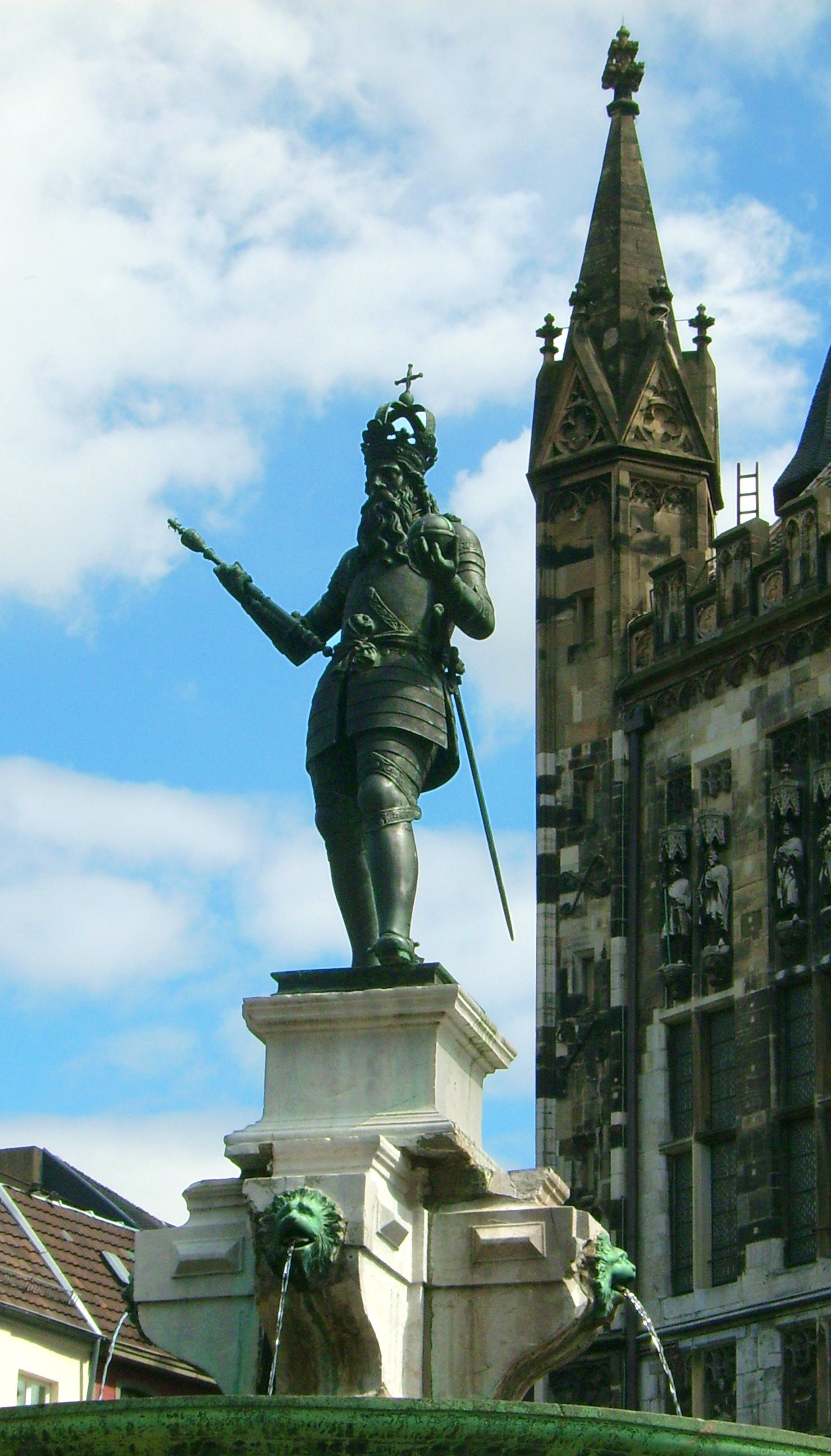Statue Of Charlemagne (Aachen) on:
[Wikipedia]
[Google]
[Amazon]
 The statue of Charlemagne is a prominent public sculpture representing
The statue of Charlemagne is a prominent public sculpture representing
File:20140822 aachen016.JPG, The statue as displayed in ''Centre Charlemagne'' in 2014
File:Sala Karola Wielkiego w Akwizgranie.jpg, The statue in Aachen Town Hall, in 2013 before its transfer to the current location
File:Karl der Große (6697668117).jpg, Detail of head
 The statue of Charlemagne is a prominent public sculpture representing
The statue of Charlemagne is a prominent public sculpture representing Charlemagne
Charlemagne ( , ) or Charles the Great ( la, Carolus Magnus; german: Karl der Große; 2 April 747 – 28 January 814), a member of the Carolingian dynasty, was King of the Franks from 768, King of the Lombards from 774, and the first ...
in Aachen. It was first erected in 1620 on the ''Marktplatz'' in front of Aachen Town Hall
Aachen Town Hall (''German:'' "Rathaus") is a landmark of cultural significance located in the ''Altstadt'' of Aachen, Germany. It was built in the Gothic architecture style in the first half of the 14th century.
History
Aachen Town Hall was b ...
, as part of the monumental ' fountain. The statue now standing on the ''Karlsbrunnen'' is a 1969 copy, and the original has been kept since 2014 at the nearby museum. It has become the most popular image of Charlemagne in the monarch's chosen capital of Aachen.
History
A medieval fountain was erected on the ''Marktplatz'' around 1334. The current statue was cast in Dinant, on a design by Peter von Trier and his nephew Frans von Trier of the , whereas the 6-ton fountain basin was cast in Aachen. The fountain was modified byJohann Joseph Couven
Johann Joseph Couven (10 November 1701 – 12 September 1763) was a German Baroque architect. He was born in Aachen, where he also died. His legacy includes several religious and secular buildings in Germany (mostly in or near Aachen, e.g. ...
in the 1730s. The statue was appropriated by French troops during the Rhineland Campaign of 1792 and transferred to Paris, but Napoleon
Napoleon Bonaparte ; it, Napoleone Bonaparte, ; co, Napulione Buonaparte. (born Napoleone Buonaparte; 15 August 1769 – 5 May 1821), later known by his regnal name Napoleon I, was a French military commander and political leader who ...
gave it back to Aachen in June 1805 upon a request from Aachen Mayor , who had visited Paris in December 1804 and attended Napoleon's coronation ceremony
A coronation is the act of placement or bestowal of a crown upon a monarch's head. The term also generally refers not only to the physical crowning but to the whole ceremony wherein the act of crowning occurs, along with the presentation of ot ...
. It was removed again during World War II
World War II or the Second World War, often abbreviated as WWII or WW2, was a world war that lasted from 1939 to 1945. It involved the vast majority of the world's countries—including all of the great powers—forming two opposing ...
for protection and kept in the town hall's basement until re-erection in 1948.
in 1969, the statue was deposed on preservation grounds and replaced by the current copy. The original was exhibited in the town hall's Coronation Hall (''Krönungssaal'') until the creation of the Centre Charlemagne on the former Imperial palace ground or ', where it has been kept since 2014, the 1200th anniversary of Charlemagne's death.
Gallery
See also
*Equestrian statue of Charlemagne (Cornacchini)
The ''Equestrian statue of Charlemagne'' (1725), which portrays the Holy Roman Emperor Charlemagne (742–814), was commissioned by Pope Clement XI (1649–1721) and carved by the Italian artist Agostino Cornacchini (1686–1754). It stands to th ...
* Alte Brücke (Frankfurt)
* Statue of Charlemagne (Liège)
The statue of Charlemagne is a prominent public monument topped by an equestrian statue of Charlemagne in Liège, created by sculptor Louis Jehotte in 1867.
History
Louis Jehotte suggested the idea of the monument to the city of Liège in 185 ...
* Charlemagne et ses Leudes
, generally translated as Charlemagne and His Guards or Charlemagne and His Paladins, is a monumental bronze statue situated on the plaza (''parvis'') in front of Notre-Dame, in the 4th arrondissement of Paris, France. A joint work by the brothe ...
* Iconography of Charlemagne
The rich iconography of Charlemagne is a reflection of Charlemagne's special position in Europe's collective memory, as the greatest of the Frankish kings, first Holy Roman Emperor, unifier of Western Europe, protector of the Catholic Church, prom ...
Notes
Cultural depictions of Charlemagne Fountains in Germany Outdoor sculptures in Germany Monuments and memorials in North Rhine-Westphalia {{sculpture-stub